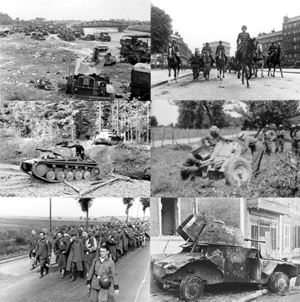Germany’s Invasion of Benelux and Northern France: May 10th, 1940
On May 10th, 1940, Germany launched a military campaign known as Fall Gelb, or Case Yellow, which marked a significant turning point in World War II. This operation involved the invasion of Belgium, the Netherlands, Luxembourg, and northern France, and ultimately led to the German occupation of these territories. The invasion was a swift and brutal offensive, characterized by the strategic use of panzer tanks and the bypassing of the heavily fortified Maginot Line.
The Ardennes Forest and the Bypassing of the Maginot Line
One of the key elements of Germany’s strategy during the invasion was the decision to bypass the Maginot Line, a line of fortifications built by France along its border with Germany. To achieve this, the German Wehrmacht, led by their panzer tanks, chose to cross through the Ardennes Forest. This dense and hilly terrain was considered impassable by the Allies, making it an unexpected and vulnerable point of attack.
The decision to go through the Ardennes Forest caught the Allies off guard. They had believed that the Maginot Line would be an impenetrable barrier, and thus focused their defenses primarily on the northern and eastern borders. This allowed the German forces to make significant progress and quickly advance towards their objectives.
The Occupation of Belgium and Northern France
As the German forces pushed forward, they encountered little resistance from the Belgian and Dutch armies. The surprise attack and the rapid advancement of the panzer tanks left the defending forces overwhelmed and unable to mount an effective defense. Within a matter of weeks, Belgium and northern France were occupied by the German forces.
The occupation of these territories had significant consequences for both the local populations and the overall progress of the war. The German forces established a strict regime, imposing their authority and implementing policies that aimed to control the occupied territories. These policies included the suppression of local resistance movements, the requisitioning of resources, and the enforcement of German rule.
The occupation also had a profound impact on the course of the war. With the fall of Belgium and northern France, the German forces gained a strategic advantage, as they now had direct access to the English Channel. This not only allowed for the potential invasion of Britain but also disrupted the supply lines of the Allied forces.
Historical Significance and Legacy
The invasion of Benelux and northern France on May 10th, 1940, marked a turning point in World War II. It demonstrated the effectiveness of the German blitzkrieg strategy, which relied on fast and coordinated attacks to overwhelm the enemy. The success of Fall Gelb also highlighted the vulnerabilities of the Allied defenses and forced them to reassess their military strategies.
The occupation of these territories had a lasting impact on the local populations. Many individuals and families were displaced, and their lives were profoundly disrupted by the German occupation. Resistance movements emerged, seeking to undermine German control and support the Allied cause. These movements played a crucial role in the eventual liberation of the occupied territories.
To learn more about this historical event, you can refer to the following external references:
- History.com: German Occupation of Belgium and France
- Britannica: The German Invasion of the Low Countries and France
- National WWII Museum: The German Invasion of the West
Overall, the invasion of Benelux and northern France in May 1940 was a significant event that reshaped the course of World War II. It highlighted the effectiveness of German military tactics and exposed weaknesses in Allied defenses. The occupation of these territories had a profound impact on the local populations and the progress of the war. Understanding this historical event is crucial for comprehending the complexities and consequences of World War II.

